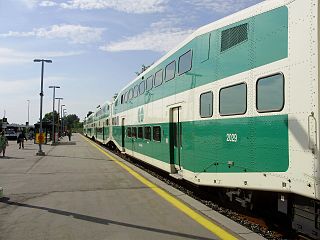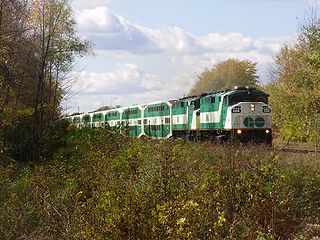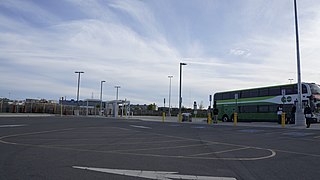
GO Transit is a regional public transit system serving the Greater Golden Horseshoe region of Ontario, Canada. With its hub at Union Station in Toronto, GO Transit's green-and-white trains and buses serve a population of more than seven million across an area over 11,000 square kilometres (4,200 sq mi) stretching from Kitchener in the west to Peterborough in the east, and from Barrie in the north to Niagara Falls in the south. In 2023, the system had a ridership of 56,036,900. GO Transit operates diesel-powered double-decker trains and coach buses, on routes that connect with all local and some long-distance inter-city transit services in its service area.

Union Station is a major railway station and intermodal transportation hub in Toronto, Ontario, Canada. It is located on Front Street West, on the south side of the block bounded by Bay Street and York Street in downtown Toronto. The municipal government of Toronto owns the station building while the provincial transit agency Metrolinx owns the train shed and trackage. Union Station has been a National Historic Site of Canada since 1975, and a Heritage Railway Station since 1989. It is operated by the Toronto Terminals Railway, a joint venture of the Canadian National Railway and Canadian Pacific Railway that directs and controls train movement along the Union Station Rail Corridor, the largest and busiest rail corridor in Canada.

Lakeshore West is one of the seven train lines of the GO Transit system in the Greater Toronto Area, Ontario, Canada. It extends from Union Station in Toronto to Hamilton, along the shore of Lake Ontario. Some train trips extend past Hamilton to St. Catharines and Niagara Falls.

Kitchener is one of the seven train lines of the GO Transit system in the Greater Toronto Area, Ontario, Canada. It extends westward from Union Station in Toronto to Kitchener, though most trains originate and terminate in Brampton in off-peak hours.

Barrie is one of the seven train lines of the GO Transit system in the Greater Toronto Area, Ontario, Canada. It extends from Union Station in Toronto in a generally northward direction to Barrie, and includes ten stations along its 101.4 kilometres (63.0 mi) route. From 1982 to 1990 and again from 1993 to 2007, it was known as the Bradford line, named after its former terminus at Bradford GO Station until the opening of Barrie South GO Station.

Lakeshore East is one of the seven commuter rail lines of GO Transit in the Greater Toronto Area, Ontario, Canada. It extends from Union Station in Toronto to Oshawa GO in Durham Region. Buses from Oshawa connect to communities further east in Newcastle, Bowmanville and Peterborough.

Bradford GO Station is a railway station and bus station in the GO Transit network located in Bradford, Ontario in Canada. It is 67 km north of Union Station in downtown Toronto, and was the terminus of the Bradford line before it was extended to Barrie and renamed the Barrie line on December 17, 2007.

The Union Pearson Express is an airport rail link connecting Union Station in Downtown Toronto to Toronto Pearson International Airport. The UP Express began operation on 6 June 2015, in time for the 2015 Pan American Games. The UP Express travels between Union and Pearson in 25 minutes departing every 15 minutes, seven days a week. At the launch announcement, it was stated that the UP Express was projected to carry 2.35 million passengers annually and eliminate approximately 1.2 million car trips in the first year. As of 2019, it carried 4.5 million passengers annually.

Oakville GO Station is a GO Transit railway station and bus station in Oakville, Ontario, Canada. It is colocated and shares platforms with Via Rail's Oakville railway station.

Durham College Oshawa GO station is a station for commuter rail, passenger rail and regional bus services in Oshawa, Ontario, Canada. It is the terminal station for the Lakeshore East line of GO Transit and serves Via Rail's Corridor service, which travels from Toronto to both Ottawa and Montreal. The bus terminal is served by bus routes of GO Transit and Durham Region Transit.

The Presto card is a contactless smart card automated fare collection system used on participating public transit systems in the province of Ontario, Canada, specifically in Greater Toronto, Hamilton, and Ottawa. Presto card readers were implemented on a trial basis from 25 June 2007 to 30 September 2008. Full implementation began in November 2009 and it was rolled out across rapid transit stations, railway stations, bus stops and terminals, and transit vehicles on eleven different transit systems.

The Big Move is the regional transportation plan (RTP) published by Metrolinx for the Greater Toronto and Hamilton Area (GTHA) in Ontario, Canada. It makes specific recommendations for transit projects, resulting from seven "green papers" and two "white papers" released for public discussion. A draft RTP was released alongside draft investment strategy in September 2008. After a series of stakeholder consultations and public meetings, the final RTP was approved and published by Metrolinx on 28 November 2008.
MoveOntario 2020 was a 2007 plan proposed by the Government of Ontario that would fund 52 rapid-transit projects throughout the Greater Toronto and Hamilton Area in Ontario, Canada. It was succeeded by The Big Move and GO Transit's Go 2020.
GO Transit is an interregional public transit system in Southern Ontario, Canada, operated by the provincial crown agency Metrolinx. It primarily serves the conurbation referred to by Metrolinx as the "Greater Toronto and Hamilton Area" (GTHA) with operations extending to several communities in the area centred around Toronto and Hamilton.

West Harbour GO Station is a regional rail station in the North End neighbourhood of Hamilton, Ontario, Canada. The station has been served by GO Transit's Lakeshore West line since July 9, 2015. There is hourly service between West Harbour and Toronto's Union Station, seven days a week. Via Rail service may eventually be provided.

The A-Line is a proposed rapid transit line running along James Street in downtown and Upper James Street on the escarpment in Hamilton, Ontario. It is part of Hamilton's proposed BLAST network, involving four other rapid transit corridors. It is identified by Metrolinx in its regional transportation plan The Big Move as a project to be completed by 2023. The route is currently served by Hamilton Street Railway's Route 20 A-Line Express bus.

Confederation GO Station is a GO bus stop and planned train station to be built by Metrolinx in East Hamilton, Ontario. The station is named for Confederation Beach Park, nearby on Lake Ontario.
The Big Move is a regional transportation plan (RTP) published in 2008 and consisting of 62 rapid transit projects to be implemented across the Greater Toronto and Hamilton Area (GTHA). These rapid transit projects are intended to form a seamlessly integrated regional rapid transit network, which is the first priority action in the regional transportation plan. These projects form two long-term templates with 15 and 25 year horizons. These templates outline broad projects; specific details about technology, alignment, stations and service levels for each project are subsequently determined though a cost–benefit analysis or an environmental assessment process.

GO Expansion, previously known as GO Regional Express Rail (RER), is a project to improve GO Transit train service by adding all-day, two-way service to the inner portions of the Barrie line, Kitchener line and the Stouffville line, and by increasing frequency of train service on various lines to every 15 minutes or better on five of the corridors. This would be achieved with the electrification of at least part of the Lakeshore East line, Lakeshore West line, Barrie line, Kitchener line and Stouffville line. GO Expansion is one of the Big Move rapid transit projects.

GO Transit rail services are provided throughout the Greater Toronto and Hamilton Area (GTHA) and the Greater Golden Horseshoe. The GO Transit rail fleet consists of 90 MPI MP40 locomotives and 979 Bombardier BiLevel Coaches. In 2023, the system had a ridership of 40,807,100 passengers per year. GO Transit started on May 23, 1967, running single-deck trains powered by diesel locomotives in push-pull configuration on a single rail line along Lake Ontario's shoreline. When GO trains began operation, they ran on tracks mostly owned the two major freight railways of Canada: Canadian National (CN) and CPKC. Over time, GO Transit have acquired tracks, ensuring GO Transit has control over track maintenance and expansion. Metrolinx currently owns 80% of the GO's rail corridors.






















